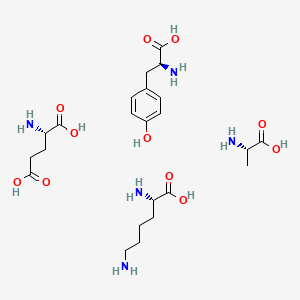



API Suppliers

US DMFs Filed

CEP/COS Certifications
0

JDMFs Filed
0
Other Certificates
0
Other Suppliers

USA (Orange Book)
0

Europe

Canada
0

Australia
0

South Africa
0
Uploaded Dossiers
U.S. Medicaid
0
Annual Reports
0


1. 28704-27-0
2. Cop-1
3. (2s)-2-amino-3-(4-hydroxyphenyl)propanoic Acid;(2s)-2-aminopentanedioic Acid;(2s)-2-aminopropanoic Acid;(2s)-2,6-diaminohexanoic Acid
4. Dtxsid50182865
| Molecular Weight | 563.6 g/mol |
|---|---|
| Molecular Formula | C23H41N5O11 |
| Hydrogen Bond Donor Count | 11 |
| Hydrogen Bond Acceptor Count | 16 |
| Rotatable Bond Count | 13 |
| Exact Mass | 563.28025714 g/mol |
| Monoisotopic Mass | 563.28025714 g/mol |
| Topological Polar Surface Area | 337 Ų |
| Heavy Atom Count | 39 |
| Formal Charge | 0 |
| Complexity | 488 |
| Isotope Atom Count | 0 |
| Defined Atom Stereocenter Count | 4 |
| Undefined Atom Stereocenter Count | 0 |
| Defined Bond Stereocenter Count | 0 |
| Undefined Bond Stereocenter Count | 0 |
| Covalently Bonded Unit Count | 4 |
For reduction of the frequency of relapses in patients with Relapsing-Remitting Multiple Sclerosis.
FDA Label
Glatiramer acetate was originally designed to mimic a protein in myelin, called myelin basic protein, with the intention of inducing EAE (an animal model of MS). Quite to the contrary, it was found to suppress the disease and as a result came to be trialed in human MS. There is some evidence that Glatiramer acetate converts the body's immune response from a Th1 type to a Th2 one, promotes suppressor T cells or acts as an altered peptide ligand. Studies in animals and in vitro systems suggest that upon its administration, glatiramer acetate-specific suppressor T-cells are induced and activated in the periphery. Some fraction of the injected material, either intact or partially hydrolyzed, is presumed to enter the lymphatic circulation, enabling it to reach regional lymph nodes, and some may enter the systemic circulation intact.
Hydrolyzed by proteases
Glatiramer acetate (GA) exhibits strong and promiscuous binding to MHC molecules (HLA DRB1* variants) and consequent competition with various myelin antigens for their presentation to T cells. A further aspect of its action is potent induction of specific suppressor cells of the T helper 2 (Th2) type that migrate to the brain and lead to in situ bystander suppression. Furthermore, the GA-specific cells in the brain express the anti-inflammatory cytokines IL-10 and transforming growth factor beta, in addition to brain-derived neurotrophic factor, whereas they do not express the inflammatory cytokine IFN-gamma. Recent evidence also suggests that Glatiramer acetate directly inhibits dendritic cells and monocytes - both of which are circulating antigen presenting cells.


